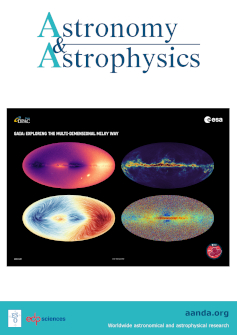来自耀斑恒星和褐矮星的射电辐射
IF 5.4
2区 物理与天体物理
Q1 ASTRONOMY & ASTROPHYSICS
引用次数: 0
摘要
上下文。中晚期矮星附近被认为是适宜行星形成的地形。然而,它们经常显示出增加的恒星活动,在寻找潜在的宜居行星系统时应考虑到这一点。为了揭示磁场对矮星多波段活动的影响,我们搜索了14915颗褐矮星和15124颗耀斑恒星的相关射电发射。我们利用了VLASS所有三个时代的第一和第二历元目录和射电图,补充了基于ROSAT, eROSITA和xmm -牛顿空间望远镜观测的x射线目录,以及TESS任务的2分钟节奏光学光曲线。对无线电探测子样本进行查询,以进行同步TESS观测,并对具有重合光曲线的源进行单独研究。我们发现褐矮星没有相关的射电辐射,而在55个耀斑恒星样本中发现了对应的射电辐射,其中7个与TESS观测结果一致。无线电探测样品遵循无线电x射线和周期-活动关系。我们发现,无线电功率与恒星表面重力、半径和质量等参数之间存在很强的相关性。我们没有发现耀斑率和无线电变异性之间的联系。对于具有有效温度和旋转周期的无线电探测恒星,我们估计了陀螺年龄,其值为Tgyro > 1 Gyr,其中大多数样本小于150 Myr。我们发现光学耀斑的发生与单独研究的恒星的射电变异性之间没有很强的联系。我们得出结论,中-晚型耀斑恒星的射电辐射具有同步辐射性质,并且与x射线过程具有共同的起源。它主要是由年轻的恒星群创造的,是恒星耀斑、吸积和日冕加热的共同贡献。本文章由计算机程序翻译,如有差异,请以英文原文为准。
Radio emission from flaring stars and brown dwarfs
Context. The vicinities of intermediate-to-late type dwarf stars are considered as an adequate terrain to host planets suitable for life to form. However, they oftentimes show increased stellar activity, which should be taken into consideration when seeking potential habitable planetary systems.Aims. With the aim to reveal the effects of the magnetic field to the multi-band activity of dwarf stars, we search for associated radio emission for an extensive list of 14 915 brown dwarfs and 15 124 flaring stars.Methods. We utilised the first and second epoch catalogues and radio maps from all three epochs of the VLASS, supplemented with X-ray catalogues based on observations by the ROSAT, eROSITA, and XMM-Newton space telescopes, and 2-minute cadence optical light curves from the TESS mission. The radio-detected sub-sample was queried for concurrent TESS observations, and sources with coinciding light-curves were studied individually.Results. We found no associated radio emission for brown dwarfs, and found 55 radio counterparts for the sample of flaring stars, out of which seven have coincident TESS observations. The radio-detected sample follows both the radio-X-ray and the period-activity relations. We found a strong correlation between the radio powers and the stellar parameters of surface gravity, radius, and mass. We found no connection between the flare rate and the radio variability. For radio-detected stars with available effective temperatures and rotational periods, we estimated gyrochronological ages, which resulted in values of Tgyro ≲ 1 Gyr, with the majority of the sample being younger than 150 Myr. We found no strong connection between the occurrence of optical flares and radio variability for the individually studied stars.Conclusions. We conclude that radio emission from intermediate-to-late type flaring stars is of synchrotron nature, and shares a common origin with X-ray processes. It is created by a predominantly young stellar population, and is the collective contribution of stellar flares, accretion, and coronal heating.
求助全文
通过发布文献求助,成功后即可免费获取论文全文。
去求助
来源期刊

Astronomy & Astrophysics
地学天文-天文与天体物理
CiteScore
10.20
自引率
27.70%
发文量
2105
审稿时长
1-2 weeks
期刊介绍:
Astronomy & Astrophysics is an international Journal that publishes papers on all aspects of astronomy and astrophysics (theoretical, observational, and instrumental) independently of the techniques used to obtain the results.
 求助内容:
求助内容: 应助结果提醒方式:
应助结果提醒方式:


